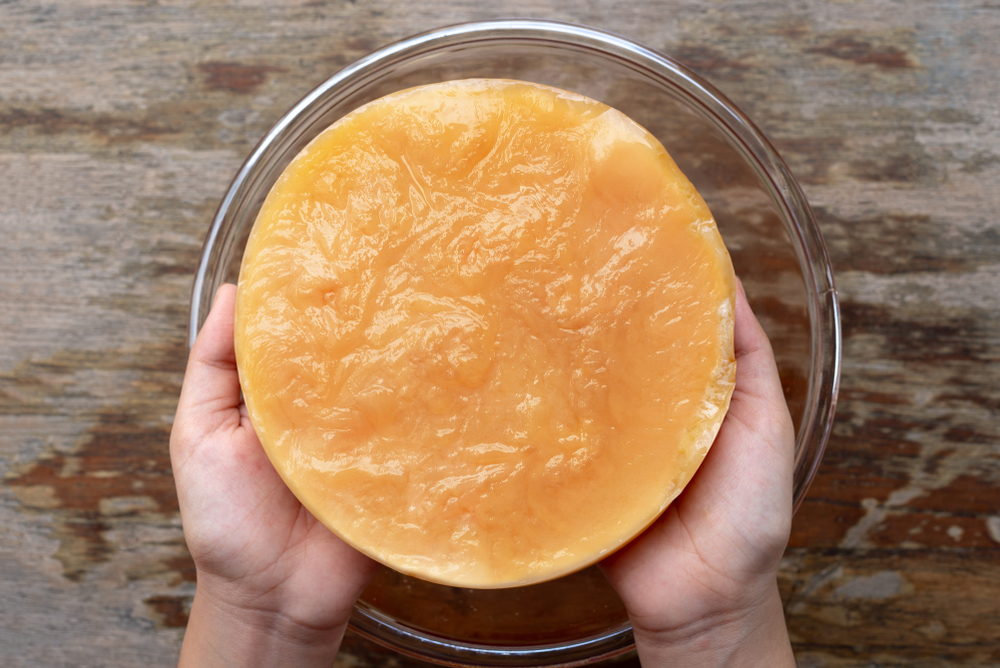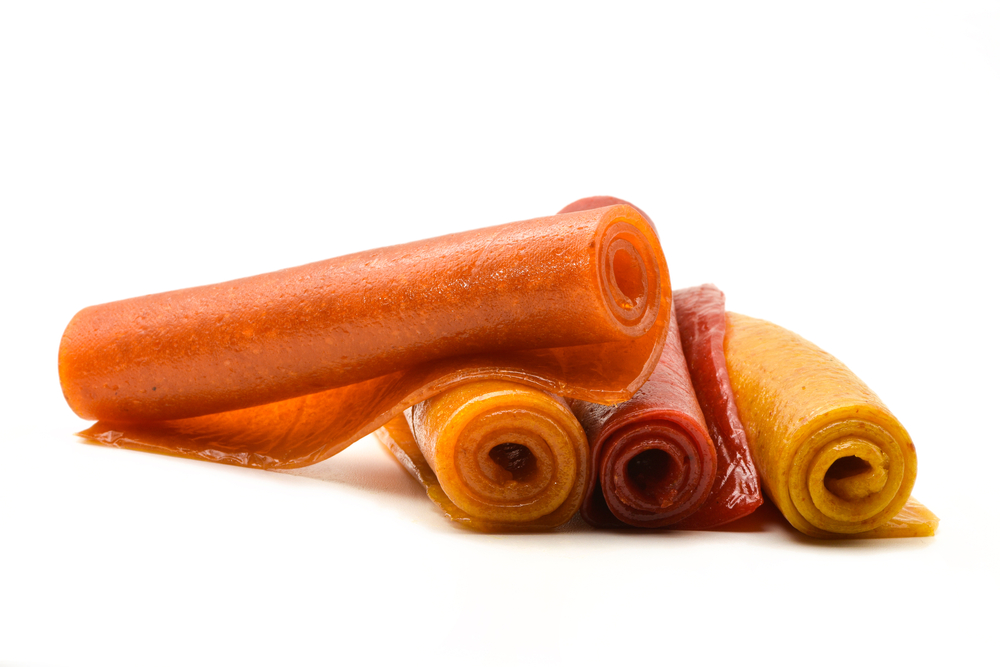After a few months of brewing kombucha, you’ll likely have more SCOBYs than you know what to do with. Instead of storing them, why not reap their health benefits? One of the best ways to use extra SCOBYs is to make SCOBY fruit leather.
Before throwing your extra SCOBYs in your garden, consider making a snack out of them. Use fresh or frozen fruit, a bit of sweetener, and SCOBY. You’ll need a high-speed blender (or food processor) and a dehydrator (or an oven) to achieve the perfect texture.
Table of Contents

SCOBY Fruit Leather
Total Time: 8 hours 25 minutes
Yield: 10–12 Servings 1x
Description
SCOBY fruit leathers are reminiscent of fruit roll-ups but much healthier. They are a great on-the-go snack for children and adults.
Ingredients
Scale
- 1 cup diced fruit (strawberries, blueberries, peaches, raspberries, etc.)
- 3 SCOBYs (enough to equal 2 cups of SCOBY puree)
- 1/2–1 cup of kombucha
- 1/4–1/2 cup sugar (maple syrup, cane sugar, or white sugar)
- 1–2 tsp spices—optional (cinnamon, basil, nutmeg, cloves, etc.)
Instructions
Dehydrator: Prepare two dehydrator trays with parchment paper or silicone dehydrator sheets as the manufacturer recommends. Make sure it is set to the lowest setting or 105 °F.
Oven: Prepare two rimmed baking sheets with parchment paper and set your oven to the lowest temperature—170 °F.
- Cook the fruit and sugar in a small saucepan on the stove. Stir frequently until the fruit breaks down and combines with the sugar, about 10 minutes. Set aside to cool.
- Puree the kombucha SCOBYs in a high-speed blender (or food processor) until they have the texture of applesauce. Make sure you have 2 cups of SCOBY puree.
- Add 1/2 cup of kombucha. Blend until well combined. Add up to 1/2 cup more kombucha if the mixture is too dry.
- Add the fruit mixture. Blend on high for 1-2 minutes until thoroughly combined.
- Taste. If you’d like a sweeter puree, add the rest of the sweetener and blend for another minute.
- Pour 1/2 of the mixture onto each tray. Smooth with a spatula until the puree is 1/4-1/8 inch thick. Make sure to spread the mixture evenly and that it reaches as close to the edges of the trays as possible.
Dehydrator: dehydrate for 12-36 hours. If the fruit leather isn’t fully set, continue cooking it for another hour or until fully set.
Oven: cook for 4-7 hours at the lowest temperature—around 170 °F. Prop the door open so the oven maintains a temperature closer to 105 °F. Check the middle of the fruit leather after 4 hours. If It’s not completely set, let it cook for one more hour or until fully set.
- Remove the trays and let them cool completely. Cut SCOBY fruit leather and parchment paper into strips.
- Roll up and store in an airtight container until ready to serve.
Notes
It’s important to dry the SCOBY fruit puree as close to 105 °F as possible. Drying at a higher temperature will kill the living microorganisms and probiotics in the SCOBY.
Cut your SCOBY fruit leather into bite-sized pieces and use it to top salads or add to trail mix.
Add two scoops of protein powder or collagen for a protein SCOBY snack.
If your SCOBY fruit leather sticks to the parchment paper, place the tray in the freezer for 1-2 hours. It should then separate.
Save your extra SCOBYs in a SCOBY hotel and puree them once or twice a month for less prep work. Store the SCOBY puree in the fridge for up to one month.
- Prep Time: 25 minutes
- Cook Time: 8 hours
What Does SCOBY Fruit Leather Taste Like?
Kombucha SCOBY fruit leather tastes sweet and tart. The exact taste depends on the fruit and spices you add. Strawberries and peaches make sweeter fruit leather. Blueberries make tart fruit leather. SCOBY fruit leather has a texture similar to a fruit roll-up or jerky—sticky and chewy.
What Are the Health Benefits of SCOBY Fruit Leather?
SCOBY is an acronym: symbiotic culture of bacteria and yeast. It turns brewed fermented tea into kombucha. The SCOBY is made up of acetic acid bacteria and lactic acid bacteria, which aid digestion.
The SCOBY also:
- Contains strands of yeast. Yeast helps build a healthy gut that will support your immune system.
- Contains probiotic bacteria strains, including Lactobacillus nagelii, among others. These probiotics support gut health and digestion. They also stop the growth of harmful bacteria that can lead to illnesses.
- Is an excellent source of antioxidants. Antioxidants can help your body produce healthy cells and reduce the risk of cancer and heart disease.
Each variety of fruit offers different health benefits:
- Blueberries are high in fiber, which helps digestion and can help lower cholesterol.
- Peaches contain beta-carotene. Your body turns this into vitamin A, which helps support eye health.
- Raspberries are a good source of potassium. Potassium lowers blood pressure and is an essential part of a healthy heart.
- Strawberries are high in vitamin C, which helps your body absorb iron and strengthens your immune system.

How Many Calories Are In SCOBY Fruit Leather?
Each SCOBY fruit roll has about 32 calories. The exact calories depend on the type of fruit and the amount of sugar you use.
For example, one cup of peaches contains 67 calories, while 1 cup of strawberries contains about 49 calories. Depending on the fruit you use, SCOBY fruit leathers may be low in carbohydrates and total fat.
Can Children Eat SCOBY Fruit Leather?
Children can absolutely eat SCOBY fruit leather. This probiotic-rich snack has no preservatives or artificial ingredients. It’s packed with vitamins, minerals, and antioxidants. It’s low in calories and only sugar. SCOBY fruit leather makes a great snack or dessert for children.

